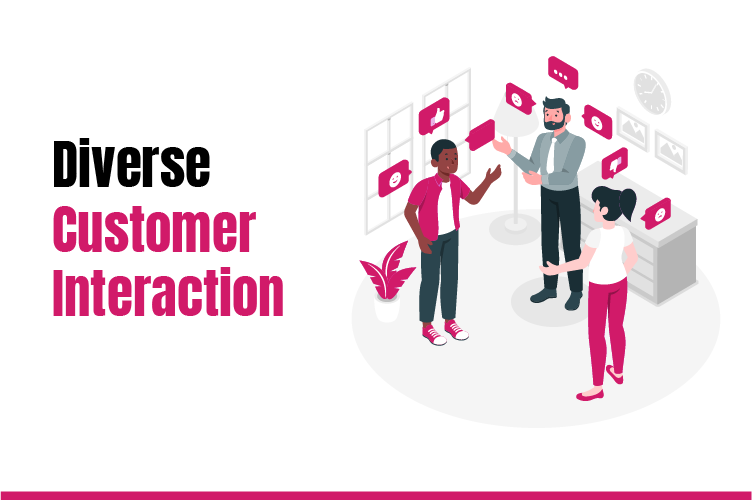The Role of Diversity and Inclusion in Customer Experience: Insights from QaizenX

Diversity and inclusion are more than just words and they’re important to creating exceptional customer experiences. Diversity and inclusion are essential for outstanding customer experiences. We’ll see how companies, such as QaizenX, use them to improve customer experiences.
Understanding the role of diversity and inclusion is key to improving customer satisfaction and loyalty. It also helps to get their full potential to make experiences better. Let’s have a look into how these principles influence customer experiences and explore practical strategies for implementation.
Understanding Diversity and Inclusion:
What diversity and inclusion exactly is? Diversity is bounded by the range of human differences, including but not limited to race, ethnicity, gender, age, sexual orientation, abilities, and more. Inclusion, on the other hand, involves creating an environment where all individuals feel valued, respected, and empowered to contribute their unique perspectives and talents.
McKinsey & Company discovered that Companies in the top 25% for gender diversity enjoy 15% better financial returns in their report Why Diversity Matters. This means they outperform others in their industry. This statistic shows the real advantage of diversity and inclusion within businesses.
Importance of Diversity and Inclusion in Customer Experience:
Let’s consider a scenario from India to understand the significance of diversity and inclusion in customer experience. Picture yourself visiting a bustling street food market on a weekend. The air is filled with the aroma of various cuisines sizzling on grills. As you walk through the market, you notice people from different backgrounds enjoying their favorite dishes together. Sitting down to enjoy a plate of chaat, you realize that the magic of the experience lies not just in the food, but also in the inclusive atmosphere created by the diverse vendors and customers. This illustrates how diversity and inclusion play a crucial role in shaping customer experiences in India.
How Does Diversity and Inclusion Influence Customer Experience?
Diversity and inclusion make a big impact on how customers feel. People like businesses that share their values and care about including everyone. A survey by Deloitte found that 83% of people think it’s important for companies to be diverse and inclusive when they decide who to do business with.
Businesses gain a lot when their employees have different points of view. This helps them understand their customers better. When customers see people like them working, it makes them feel like they belong and that the company includes everyone.
Furthermore, inclusive practices guarantee that every customer is treated with respect and has fair access to products and services, no matter where they come from.
In the end, when customers feel appreciated and heard, they’re likely to stick with the brand and even recommend it to others. This helps spread positive word-of-mouth and boosts the business’s success.
Implementing Diversity and Inclusion Strategies for Better Customer Experience
Conduct Bias Training:
- Offer thorough bias training for employees to help them learn about hidden biases. Research indicates that 76% of employees who go through this training become more aware and sensitive to diversity issues.
- Hold regular workshops and seminars to teach employees about why diversity and inclusion are important. This helps create a friendly environment for customers.
Implement Inclusive Recruitment Practices:
- Update hiring processes to make sure they include everyone, no matter their background. Studies show that companies with diverse hiring strategies perform 35% better than their competitors.
- Think about using blind resume screening to reduce biases and evaluate qualifications fairly, without considering demographic factors.
Establish Employee Resource Groups:
- Start employee resource groups (ERGs) to support diversity and inclusion at work. These groups give employees a place to share, help each other, and push for positive changes. Businesses with active ERGs see a 12% boost in how engaged their employees are.
- Encourage employees at all levels to join ERGs to work together and make a difference. This helps everyone collaborate and come up with important ideas.
Regularly Measure Progress:
- Set up ways to regularly check how well diversity and inclusion efforts are going. Studies show that organizations that keep track of diversity are 25% more likely to have good results.
- Use important measures like surveys about employee involvement, numbers showing representation, and opinions from diversity groups to see how things are going and find areas to get better.
Promote Inclusive Leadership:
- Encourage a culture of inclusive leadership, where leaders actively support diversity and inclusion in decision-making. Businesses with diverse leadership teams are 33% more likely to make more profit.
- Offer leadership training programs that focus on diversity and inclusion. These programs help leaders gain the skills they need to support inclusive practices and build a culture where everyone feels like they belong.
Welcoming diversity and inclusion isn’t just the right thing to do—it’s also good for business. Moreover, as Maya Angelou wisely said, “We all should know that diversity makes for a rich tapestry, and we must understand that all the threads of the tapestry are equal in value no matter their color.” By using these strategies, businesses can create a more inclusive environment. Additionally, this not only makes employees happier but also improves the customer experience. In conclusion, embracing diversity and inclusion benefits both employees and customers, leading to overall success in business.
Measuring Success
It’s important to measure how well diversity and inclusion efforts are doing to keep getting better. For example, we can look at things like how engaged employees are, how diverse our teams are, how many people stay with us, and what diversity groups say. Tracking these things helps us find ways to improve and celebrate our successes. Moreover, when we track these metrics, we can understand where we need to improve and what’s already working well. Additionally, by celebrating our successes, we can motivate ourselves to keep making progress. Ultimately, these efforts lead to a more inclusive and successful workplace for everyone.
Key Takeaways of Customer Experience Through Diversity & Inclusion:
In conclusion, diversity and inclusion are important for how customers feel. Moreover, companies like QaizenX show that welcoming diversity not only makes employees happier and more innovative but also improves the overall customer experience.
As we deal with the changing business world, let’s ask: How can we make diversity and inclusion a priority for outstanding customer experiences that resonate with our diverse customers? Also, Every business owner should understand, The importance of measuring customer experience metrics and how to use them to make data-driven business decisions.
Case Study: QaizenX’s Approach:
QaizenX, a popular tech company, proves how diversity and inclusion matter for making customers happy. They pay attention to diversity when hiring and make sure everyone feels included. This helps them find great talent and keeps customers satisfied.
Recent Posts
- 20 Examples Of Employee Feedback In The Workplace
- How to Obtain Valuable Input from Your Audience for Enhanced Product Development (and Increased Sales)
- 4 E’s of Employee Engagement and How To Implement Them
- How To Choose The Right Customer Experience Management Software For Your Business
- Why Customers Leave: Recognizing the Signs and Strategies for Retention





